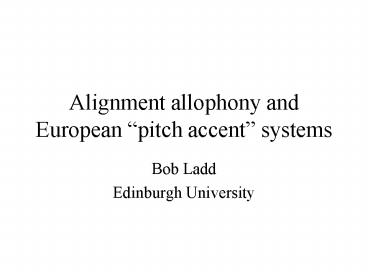Alignment allophony and European pitch accent systems PowerPoint PPT Presentation
1 / 21
Title: Alignment allophony and European pitch accent systems
1
Alignment allophony and European pitch accent
systems
- Bob Ladd
- Edinburgh University
2
European word pitch systems
- Two lexically distinct phonetic treatments of
stressed syllables - Usually restricted to long/heavy syllables (esp.
two-sonorant-mora syllables) - Low functional load / high predictability
3
European word pitch systems
- Scandinavian
- Central Franconian
- Lithuanian
- South Slavic
- Scots Gaelic (?)
- Etc ?
4
Gaelic word-pitch contrasts
- Contrast between underlying long vowel and
sequence of vowels in hiatus - VV (lt VCV)
- is phonetically distinct from
- VV ( V)
5
Realisation of Gaelic contrasts (Northern
Hebrides)
- long-vowel cases realised with sustained or
rising pitch vowels-in-hiatus cases realised
with clear F0 fall - bodha po underwater rock vs. bó po
cow
6
Why not a contact phenomenon?
- Most languages with word pitch systems are found
in isolated areas - Most are closely related to other languages or
lg. varieties that dont have such systems - In contact situations, word pitch systems tend to
disappear (e.g. Swedish in Finland)
7
Typical historical triggers
- Apocope
- e.g. Limburg Dutch
- 1dax lt MHG daV days
- vs. 2dax ltMHG dax day
- Loss of intervocalic consonant
- e.g. Scots Gaelic
8
Phonologisation accounts
- Frings 1916 allophonic duration differences
between mono- and disyllables - Öhman 1967 allophonic pitch contour differences
between mono-and disyllables - Etc.
9
Central Franconian developments (Gussenhoven 2000)
- Sing.
Pl. - MHG dax da??
- OSL dax da???
- Apocope dax da?x
- Fake AL ?dax da?x
- Reinterpretation dax da?x
- H
10
Alignment allophony
- Dutch accentual H is aligned earlier with
phonologically long vowels than short vowels,
irrespective of actual duration (Ladd et al.
2000) - English, Spanish, Dutch nuclear H is aligned
earlier than prenuclear H (Steele 1986 Nibert
2000 Schepman et al. forthcoming). - Greek nuclear L is aligned earlier in
phrase-final syllable than elsewhere (Arvaniti et
al., submitted) - English nuclear H is aligned earlier in
one-accent phrase than in two-accent phrase (Ladd
et al., work in progress)
11
German syllabic nasals
- Common for /-?n/ sequences to be realised as
-?? after most consonants, assimilated in place
to preceding consonant. E.g. - /k????/ realised as ?????
- /?????/ realised as ?????
- What do such transcriptions actually mean?
12
German test pairs
- Das Kind ist auf den grossen Stein geklettert
- The child climbed onto the big rock
- Das Kind hat auf den grossen Steinen gesessen
- The child sat on the big rocks
- Das kann sie nicht She cant do that
- Das können sie nicht They cant do that
13
Secondary splits
- German umlaut
- CuCi gt CyCi gt CyC?
- CuCa CuCa gt CuC?
14
Priming effect (Kiparsky 1995)
- the textbooks draw a discreet veil over the
other cases where the redundant feature simply
disappears when the triggering environment is
lost - the merger of voiced and voiceless consonants
normally leaves a tone/register distinction only
in languages which already possess a tone system
Svantesson 1989
15
If phonologisation is a two-stage process
- No contradiction between my proposal and e.g.
Gussenhovens both necessary - Explanation for relatively marginal status of
word pitch distinctions in Europe - And yet
16
European sources of alignment allophony
- Common for European languages to have
- Distinctive vowel and/or consonant quantity
- Complex phonotactics (allowing codas and
consonant clusters) - Strong dynamic stress
- All are likely to affect alignment and/or to lead
to sound changes that may affect conditioning
factors.
17
Realisation of Scandinavian contrasts
- EITHER Accent 2 marked by pitch feature
(prelinked tone?) (Swedish) - OR Accent 1 marked by glottal feature (Danish)
18
Realisation of Gaelic contrasts (Southern
Hebrides)
- vowels-in-hiatus cases realised with some sort of
glottal feature long-vowel cases realised with
normal phonation - bodha po/? vs. bó po
19
Central Franconian (Gussenhoven and others)
- Limburg has clearly tonal realisation in which
Accent 2 cases are marked. - Cologne has duration involving duration and
intensity effects in which Accent 1 cases are
marked.
20
Summary of similarities
- EITHER Accent 2 cases realised by pitch feature
(Swedish, Northern Hebrides, Limburg) - OR Accent 1 cases realised by some sort of
glottal feature (Danish, Southern Hebrides,
Cologne)
21
Explanation for complementary realisations of
lexical accent
- If its based on alignment allophony, and
- If its hard to phonologise in a European
language, then - An obvious way to fit it into the phonology is to
mark either the early alignment cases (Danish,
Southern Hebrides, Cologne) or the late alignment
cases (Swedish, Northern Hebrides, Limburg). - Note that in Lithuanian and S. Slavic the early
alignment cases are marked.

